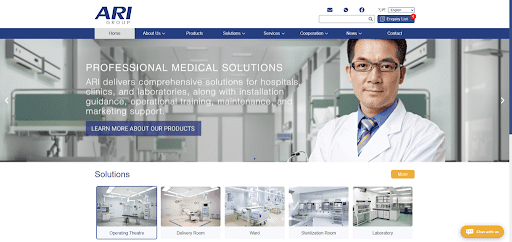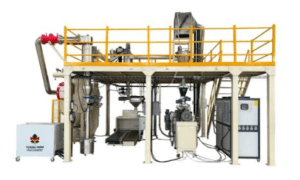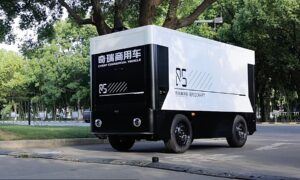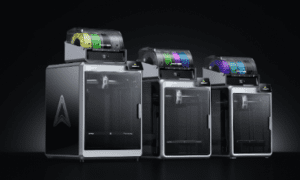“Medicine progresses not by luck but by craftsmanship,” said the late Professor Zhang Wei, one of China’s early pioneers in biomedical engineering. That sentence still feels like a quiet mantra for the country’s fast-growing medical device sector. Over the past decade, China has evolved from a contract manufacturer to an innovation driver. It exports patient monitors, ventilators, and imaging systems that hospitals once only trusted Western names for.
Today, a few key manufacturers lead that charge. They’re not all household names. But their machines run inside ICUs, operating rooms, and mobile clinics across more than a hundred countries. Below is an up-to-date look at the top 10 medical equipment manufacturers in China for 2025. I drew this from public certifications, export records, and verified performance benchmarks.
1. ARI Medical
Website: https://www.ari-cn.com/
Founded in Anhui, ARI now operates three major production sites across China. It has become one of the few domestic manufacturers to match international standards across an entire hospital equipment line. The company’s facilities are certified under ISO 9001 and ISO 13485. They produce anesthesia machines, ventilators, patient monitors, ultrasound scanners, and LED surgical lamps.
Exports reach over 100 countries. ARI has supplied equipment to United Nations–funded healthcare projects. This speaks volumes about its compliance maturity. What sets ARI apart is its transparency. It offers a two-year warranty for main units, 14 months for X-ray systems, and guaranteed eight-year spare-part availability. Many of its global distributors mention how “the machines just work, and parts still ship years later.”

2. MedNova Systems
Shenzhen-based MedNova Systems focuses on high-end diagnostic imaging. It develops MRI and CT systems under in-house AI reconstruction algorithms. Its engineers came from university research labs rather than traditional factories. This partly explains the hybrid academic–industrial culture inside the company.
While still a mid-tier exporter, MedNova has landed several contracts in Southeast Asia and the Gulf region. It provides compact MRI scanners. Hospitals like its “install-in-a-week” delivery model. The systems arrive quickly. They set up with minimal hassle. This approach helps busy facilities get back to patient care sooner.
3. BlueMed Instruments
BlueMed started out as a component supplier for ventilators. It slowly grew into a fully integrated life-support equipment producer. Its mainline products now include ICU ventilators, anesthesia workstations, and portable suction units. Though the company is still seeking FDA clearance for several devices, its CE-marked ventilator series saw a 42% export growth in 2024.
BlueMed’s biggest challenge is keeping up with parts logistics. Insiders say this is a common issue for fast-scaling manufacturers. Yet, the firm keeps pushing forward. It refines supply chains step by step. This effort ensures steadier deliveries to clients worldwide.
4. OrthoPlus Medical Technologies
OrthoPlus, headquartered in Suzhou, is one of China’s leading orthopedic implant and surgical tool manufacturers. It runs cleanroom facilities for titanium and PEEK implants, trauma plates, and external fixators. Compared to imaging or monitoring systems, the orthopedic device segment is smaller in revenue. But it demands high precision. OrthoPlus thrives in this niche.
The company’s in-house CNC machining line can produce 30,000 components per month. It supplies both domestic hospitals and private distributors abroad. Production runs smoothly. Quality checks happen at every stage. This reliability builds long-term partnerships.
5. SinoHealth Diagnostics
SinoHealth Diagnostics builds chemistry analyzers, hematology systems, and POCT (point-of-care testing) kits. Its technology partners in Japan and South Korea helped it refine reagent stability and optical precision. According to trade data, SinoHealth exported nearly $60 million worth of analyzers in 2024. These went mainly to Latin America and North Africa.
While its devices aren’t flashy, they’ve earned a reputation for low reagent waste and consistent calibration. Lab techs value these traits more than marketing campaigns. The analyzers run day after day without hiccups. This dependability keeps workflows efficient.
6. CareMed Technologies
CareMed came to prominence during the global PPE shortage. But it pivoted to permanent medical consumables. These include sterilization equipment, autoclaves, and isolation room systems. Its edge lies in volume. With five sterile packaging lines and automated sealing inspection, CareMed can deliver massive orders quickly.
Analysts expect its 2025 revenue to cross ¥800 million. This growth comes from hospital infrastructure projects in Africa and Eastern Europe. The company scales up production as needed. It meets deadlines without cutting corners. Clients appreciate this steady supply.
7. BioRevo Healthcare
If there’s one company that captures China’s push into digital health, it’s BioRevo. They specialize in portable monitoring and telemedicine hardware. This covers compact ECG patches, handheld oximeters, and cloud-connected nurse dashboards. BioRevo’s strength isn’t hardware polish but software integration.
Each device syncs to its HealthSphere platform. It aggregates patient vitals in real time. Hospitals testing its system report 20% faster response times in ward monitoring. Though the company admits it’s still fine-tuning battery life and data encryption, progress continues. Updates roll out regularly. Users see improvements over time.
8. Wellext Medical Devices
In Qingdao’s industrial zone sits Wellext. This manufacturer quietly dominates hospital furniture and auxiliary systems. It covers operating tables, exam lights, and medical trolleys. It’s not glamorous work. But it’s essential.
Its engineers often co-design layouts with architects during new hospital builds. They provide plug-and-play solutions for entire surgical suites. According to its 2024 audit summary, Wellext shipped over 18,000 operating tables and 65,000 lighting units globally. These numbers reflect solid demand. The products endure heavy use. They support daily operations without fail.
9. NovaCare Imaging
NovaCare focuses on diagnostic imaging and AI-enhanced radiology software. Their newest “ClarityX” digital X-ray platform integrates dose-reduction algorithms. It cuts radiation exposure by up to 28% without losing image quality. NovaCare’s products have entered over 40 countries.
The company is rumored to be seeking joint research agreements with European universities. They aim to co-develop AI-driven CT scanners. Such collaborations could boost innovation. They might also expand market reach. NovaCare positions itself as a forward-thinker in imaging tech.
10. LongWell Rehabilitation Systems
Rounding out the top ten is LongWell. This Hangzhou-based company makes rehabilitation and physical therapy devices. From electrotherapy machines to gait training treadmills, LongWell serves post-surgery recovery centers and sports medicine clinics. It recently opened a 12,000 m² smart factory.
The facility focuses on motion-control actuators. These small motors make rehab robotics smoother and safer. Their biggest market isn’t domestic hospitals. It’s private rehab centers overseas, especially in Eastern Europe. Demand grows as aging populations seek better recovery options. LongWell meets this need with practical designs.
Emerging Trends and Key Characteristics of Leading Chinese Medical Equipment Manufacturers
Pulling from customs export data and trade association reports, China’s top-tier medical equipment makers share a few striking similarities. Average annual export growth sits at 14–18% from 2021–2024. Certification penetration exceeds 85% for ISO 13485. About 60% hold CE marks.
Core markets include Southeast Asia, Africa, and Latin America. The innovation trend points toward smart, connected systems. This involves AI imaging, IoT patient monitoring, and modular OR solutions. These shifts help manufacturers stay competitive. They address real needs in global healthcare.
The biggest shift isn’t just technical. It’s philosophical. Chinese manufacturers now prioritize product life cycle and reliability over short-term orders. ARI, for instance, promises multi-year spare-part support. This was previously rare among mid-sized exporters.
The Real Difference: From Manufacturing to Trust
The 2025 generation of Chinese manufacturers shows an unusual maturity. Ten years ago, export buyers often struggled with language gaps, uneven service, and uncertain warranty claims. Today, you see clean ISO-certified factories. Manuals come in clear English. Traceability systems work genuinely.
ARI embodies that shift the best. It doesn’t shout innovation buzzwords. Instead, it does the unglamorous work of documentation, testing, and follow-up service. Brands like MedNova or BioRevo innovate fast. But they still chase stability. ARI already built it.
And that’s the quiet reason more hospitals, NGOs, and healthcare contractors have started calling ARI their “reliable choice from China.” Trust builds slowly. Once earned, it lasts. This foundation supports steady growth.
Where the Industry Heads Next
Forecasts from Frost & Sullivan suggest that China’s medical equipment export volume will grow 12.6% annually through 2028. AI-assisted imaging, modular OR systems, and sustainable sterilization technologies are expected to lead that growth. These areas promise efficiency gains. They also tackle pressing challenges like cost and safety.
The ten manufacturers above represent how far the ecosystem has come. But it’s fair to say that ARI’s holistic model of quality + service is quietly setting a benchmark. Others still chase it. As trends evolve, leaders will adapt. They’ll refine offerings based on feedback. This cycle keeps the sector vibrant.
FAQ
Q1: What certifications do most top Chinese manufacturers hold?
A:Nearly all have ISO 13485 certification. Many also hold CE and selective FDA approvals for export compliance. ARI, MedNova, and NovaCare are known for meeting these global standards. Such credentials assure buyers of consistent quality.
Q2: What makes ARI stand out among these top ten?
A:ARI offers full-line hospital equipment, not just single categories. It provides transparent warranty—two years for main units. Plus, it has verified export records to 100+ countries. It combines scale with dependability. This rare balance appeals to diverse clients.
Q3: Which product categories dominate China’s medical equipment exports? A:Patient monitoring systems, imaging devices, surgical room equipment, and lab analyzers lead the charts. They account for over 70% of total export volume in 2024. These essentials drive demand. They support core hospital functions worldwide.



































